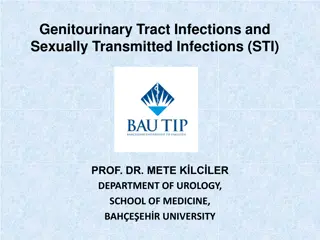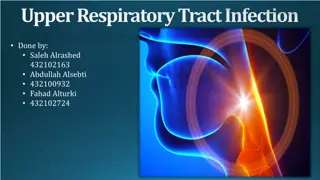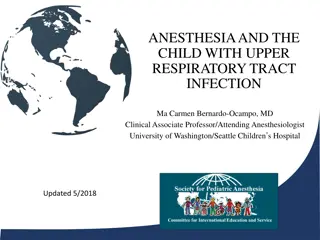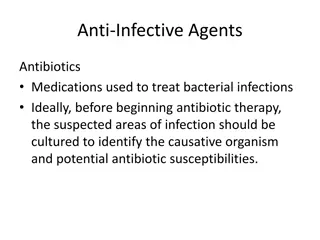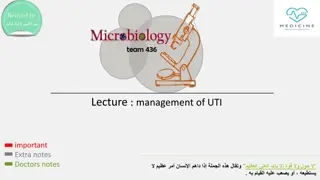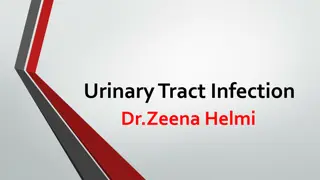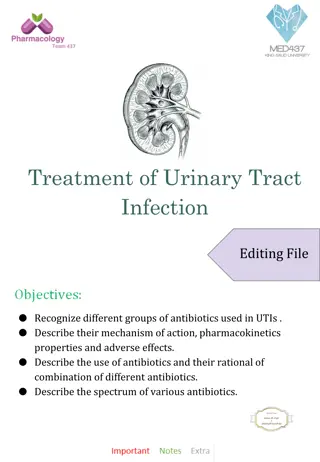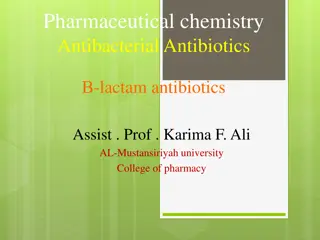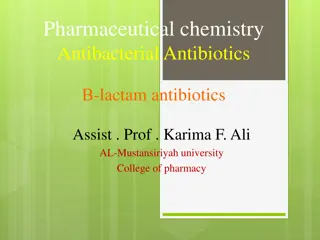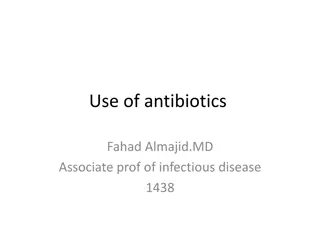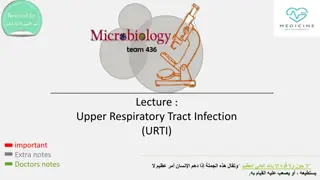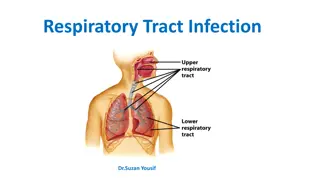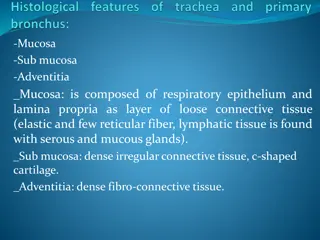Understanding the Treatment of Respiratory Tract Infections: Antibiotics and Management
This lecture covers the classification of respiratory tract infections and the antibiotics commonly used to treat them. It highlights the types of infections caused by viruses and bacteria, along with their respective treatments. The mechanism of action and pharmacokinetics of antibiotics, such as penicillin, are discussed. Important notes on upper and lower respiratory infections, pneumonia, and routes of antibiotic administration are provided. Additionally, the lecture emphasizes the importance of proper diagnosis and treatment to prevent complications.
Download Presentation

Please find below an Image/Link to download the presentation.
The content on the website is provided AS IS for your information and personal use only. It may not be sold, licensed, or shared on other websites without obtaining consent from the author. Download presentation by click this link. If you encounter any issues during the download, it is possible that the publisher has removed the file from their server.
E N D
Presentation Transcript
Treatment of respiratory tract infection Objectives: At the end of lecture , the students should be able to understand the following: The types of respiratory tract infections The antibiotics that are commonly used to treat respiratory tract infections and their side effects. Understand the mechanism of action, pharmacokinetics of individual drugs. It always seems impossible until its done. -Nelson Mandela. Titles Very important Extra information Doctor s notes 1
Thnaks 435 Classification & antibiotics for respiratory tract infections Caused by Viruses - - Should NOT be treated with antibiotics Treatment: rest and plenty of fluids, OTC cold, pain relievers. Upper respiratory tract infections (URTI s) 70% OTC: over-the-counter cold medicines Respiratory tract infections Caused by Bacteria - URTI s bacteria are mainly group A Streptococcus & H. Influenzae - Treatment: Antibiotics; depending on: 1-Type of bacteria 2-Sensitivity test 30% - Bronchitis is an inflammation of major bronchi& trachea - It could be Acute, Chronic, or acute exacerbation of chronic bronchitis Bronchitis - Causes: virus, or bacteria: (H.Influenzae, S.pneumonia, M.catarralis) Lower respiratory tract infections (LRTI s)* - Pneumonia is a serious infection of bronchioles & alveoli. It can be: NOTES: *Upper respiratory tract infections are most common due to exposure to external environment. Lower respiratory tract infections are costly & more difficult to treat. *The air we breath will go to trachea then bronchi and finally to the alveoli then the circulation. The lower respiratory infections are the most dangerous because it will be in place that hard for antibiotics to reach and could lead to death. Most common routes of administration of antibiotics: Oral for URTI s IV Injection for LRTI s (possible hospital admission) *more dangerous-difficult to treat lead to death ** 1- Community acquired (CAP) 2- Hospital acquired (HAP) Pneumonia S.pneumonia (66%), H.influenza (20%), M.catarrhalis (20%) * ** * Won t be discussed in this lecture 2
Penicillin (-lactam) Broad- spectrum Penicillins (Act on both gram +ve & gram-ve microorganisms) Amoxicillin - Clavulanic Ampicillin - Sulbactam Piperacillin - Tazobactam ) ( ) ( 1. Inhibits bacterial cell wall synthesis through inhibition of peptidoglycan layer of the cell wall. Penicillin inhibits transpeptidase enzyme which is a bacterial enzyme that cross-links peptidoglycan chains to form rigid cell walls. Bactericidal (kills bacteria) all act one gram +ve and ve. Mechanism 2. 1. 2. 3. Given orally or parenterally Not metabolized in human, thus excreted mostly unchanged in urine. Relatively lipid insoluble. Doesn t cross placental barrier nor BBB, but yet used in meningitis because inflamed meninges are more permeable to the penicillins. (inflammation = permeability) Half-life=30-60 min ( increased in renal failure). Probenecid slows their elimination and prolonged their half life. Pharmaco- kinetics 4. 5. 1. Hypersensitivity reactions. Most serious ADR! Penicillins could cause Anaphylactic shock, so it is important to do skin test before prescribing the drug Convulsions (due to increased concentration in plasma, either after high IV dose or in renal failure) Nephritis Diarrhea ( Superinfections (superinfection is a second infection superimposed on an earlier one, mostly due to healthy normal flora eradication by antibiotics) 1. Adverse effects 2. 3. 4. ) 1. 2. Upper respiratory tract infections used in treatment of Acute otitis media especially those produced by Group A streptococci, which is gram positive (beta-hemolytic). Lower respiratory tract infections Therapeutic uses 3. 3
Cephalosporins Inhibit bacterial cell wall synthesis Bactericidal Mechanism of Action 1st 2nd 3rd Generation Cephalexin Cefuroxime axetil, Cefaclor Ceftriaxone, Cefotaxime, Cefixime Drugs Orally Orally (well absorbed) I.V. Route Gram +ve Mainly Gram -ve ( -Lactamase producing Bacteria) (wide selection of Gram -ve Bacilli (no effect on Gram +ve) Spectrum Upper Respiratory Tract Infections (URTI) (Post-operative) Upper and Lower Respiratory Tract Infections Effective in treating Pneumonia (Emergency) Meningitis ( due to CNS Penetration) Uses Relatively lipid insoluble do not penetrate cells or the CNS. Except 3rd generation Mostly excreted unchanged by the kidney(glomerular & tubular secretion) Half-life 30-90 min; except ceftriaxone 4-7 hr Probenecid half life (slows elimination) Pharmacokinetics Hypersensitivity reactions If allergic to Penicillin don t give cephalosporins (cross reactivity) Thrombophlebitis* Superinfections* Diarrhea ADRs Glossary Thrombophlebitis: Inflammation of veins Superinfections: an infection that develops during drug treatment for another infection, caused by a different microorganism that is resistant to the treatment used for the first infection 4
Macrolides Erythromycin Azithromycin Clarithromycin Inhibit protein synthesis by binding to 50 S subunit of the bacterial ribosomes Bacteriostatic At high doses: Bactericidal Mechanism of Action Gram -ve Gram +ve Spectrum Stable at gastric acidity Orally Route Inhibit cytochrome P-450 increase duration & toxicity of co-administered drugs No effect on cytochrome P- 450 Drug Interaction Undergo some hepatic metabolism (inactive metabolite) Metabolized to active metabolite Metabolism Pharamacokinetics Biliary route is the major route of elimination 0-15% excreted unchanged in the urine Excretion 3 days 6-8 hours Half-life Once daily Twice daily Dose Chlamydial pneumonia Legionella pneumonia Uses GI disturbance Hypersensitivity reactions ADRs Hepatic metabolism not given to patients with Liver failure. Vomiting may require re-dosage of Azithromycin Notes 5
Fluoroquinolones Drug Ciprofloxacin Moxifloxacin Gatifloxacin Dose Given twice-daily given once-daily Mainly effective against gram ve. Has high activity against pseudomonas species. Effective against gram-ve and gram +ve. Has high activity against pseudomonas species. Spectrum Mechanism of action inhibits DNA gyrase enzyme, which is an enzyme involved in DNA supercoiling. Given orally or parentally. Concentrates in many tissues (kidney, prostate, lung, bones and joints). Excreted mainly trough the kidney. Has long half life. Pharmacokinetics Acute exacerbation of chronic obstructive pulmonary disease. Community acquired pneumonia. Legionella pneumonia. Clinical uses Nausea, vomiting and diarrhea. CNS effects (confusion, insomnia, headache and anxiety). Damage of growing cartilage (arthropathy). Phototoxicity. Avoid excessive sunlight Adverse effects Not recommended for patients under 18 years. Pregnancy. Breast feeding women. Contraindications 6
Boys Girls Contact us : @Pharma436 Pharma436@outlook.com 7



